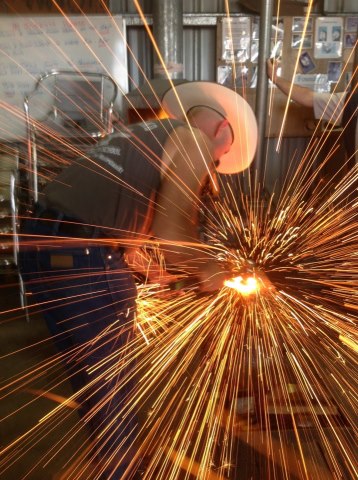As many farriers who wield a hammer at the anvil already know, forge welding can be a struggle. Yet, it doesn’t have to be a recipe for disaster. In fact, it can be as easy as baking a cake — just ask the Duncan Hines of farriery, Chris Gregory.
“If you have a box of cake mix and you have the right pan, the right oven and the right ingredients, and you follow the instructions exactly, you’ll end up making a really nice cake,” he recently told attendees of a clinic at Centaur Forge in Burlington, Wis. “Welding is exactly the same way. If you have the right forge, the right anvil, the right tools, and you handle the material correctly, welding is very simple.”
While making a cake, mixing the ingredients is a critical step. So it is with welding.
“You have to get the two steel surfaces at the right temperature,” Gregory says, “and you hit them fast and light.”
Therein lies the key. A farrier working in the fire must know how to identify the correct temperature.
“In a gas fire that’s hot enough to weld, the steel will almost disappear in the fire when it is as hot as the interior of the forge,” explains the owner of Heartland Horseshoeing School in Lamar, Mo. “In a coke fire, you will achieve a yellow heat. I like to get a very light spark off of the pieces being welded. Although, the sparking is an indication of burning, so it’s a fine line.”

The key to forge welding is getting the two steel surfaces the correct temperature and striking them fast and light, says Lamar, Mo., farrier Chris Gregory.
Another fine line is striking the metal fast and light.
“I hit it as quickly as possible with a blow that’s about 20% of full power,” Gregory explains. “Outside of the forge, the steel loses heat at an extremely fast pace. So if you’re not ready when the steel is, you’re going to lose the heat necessary to weld.”
If a blacksmith deviates from those steps, welding is going to be troublesome.
“If you’re struggling in forge welding, by-and-large there are two main reasons,” says the Delta Mustad clinician. “Either you’re not getting the steel hot enough, or you’re hitting it too hard.”
More often than not, it’s the latter scenario — with about 3 cups of anger added to the mix that ends up spoiling your recipe.
“If you have two pieces of steel that are ready to bond and you hit it too hard, one piece will draw faster than it can bond to the second piece. That’s probably the most likely reason. You tried the first time and it didn’t stick. Then you get mad and you really whack on it.”
Like most things, your results in forge welding will only be as good as your confidence.
“If you believe that you can do it, you’ll do it,” Gregory says. “If you believe that you can’t, well you’re probably right about that, too.”








Post a comment
Report Abusive Comment